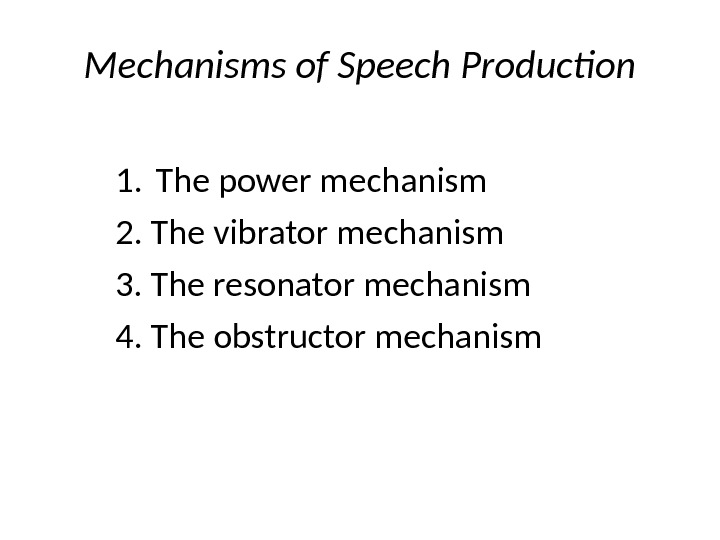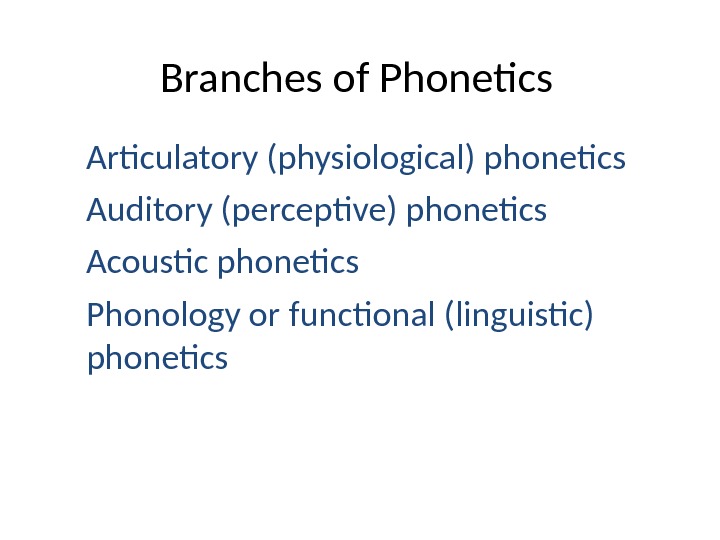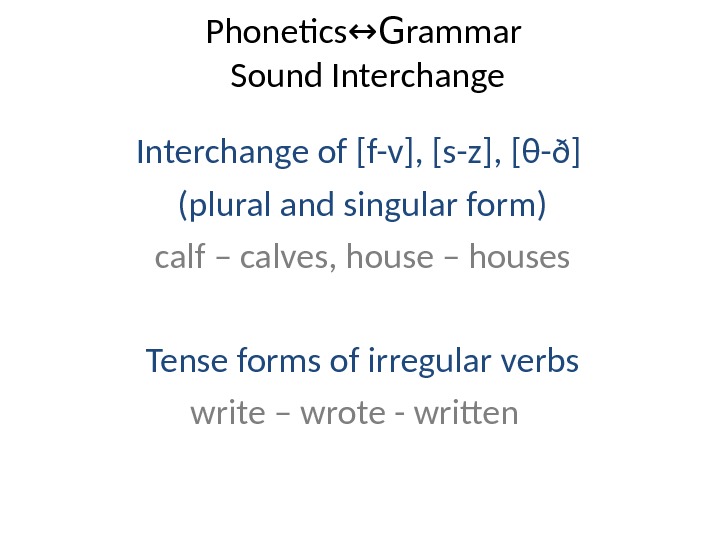Презентация subject-matter of phonetics




























- Размер: 204.5 Кб
- Количество слайдов: 27
Описание презентации Презентация subject-matter of phonetics по слайдам
 The Subject-matter of Phonetics
The Subject-matter of Phonetics
 Components of the Phonetic System of English • Speech sounds • The syllabic structure of words • Word stress • Intonation (prosody)
Components of the Phonetic System of English • Speech sounds • The syllabic structure of words • Word stress • Intonation (prosody)
 Components of Phonetics Se g me nta l phonetics Deals with individual speech sounds (“segments” of speech) Suprasegmental phonetics Is concerned with larger units of connected speech: syllables words phrases texts
Components of Phonetics Se g me nta l phonetics Deals with individual speech sounds (“segments” of speech) Suprasegmental phonetics Is concerned with larger units of connected speech: syllables words phrases texts
 Phonemes — Allophones Phonemes Serve to distinguish words and morphemes Don’t depend on the phonetic environment Allophones Variants of one and the same phoneme. Depend on the position of the sounds within the word
Phonemes — Allophones Phonemes Serve to distinguish words and morphemes Don’t depend on the phonetic environment Allophones Variants of one and the same phoneme. Depend on the position of the sounds within the word
 Phonemes • bit /b/ — pit /p/ • set /e/ — sat /æ/ • lid / ɪ / — lead /i: /
Phonemes • bit /b/ — pit /p/ • set /e/ — sat /æ/ • lid / ɪ / — lead /i: /
![Allophones light - fell [l] in light is more palatalized than [l] in fell bit – Allophones light - fell [l] in light is more palatalized than [l] in fell bit –](/docs//subject-matter_of_phonetics_images/subject-matter_of_phonetics_5.jpg) Allophones light — fell [l] in light is more palatalized than [l] in fell bit – bid [ ɪ ] in bit is shorter than [ ɪ ] in bid
Allophones light — fell [l] in light is more palatalized than [l] in fell bit – bid [ ɪ ] in bit is shorter than [ ɪ ] in bid
![Transcription symbols // - slant brackets [] – square brackets [ ˌ ] – syllabic consonants Transcription symbols // - slant brackets [] – square brackets [ ˌ ] – syllabic consonants](/docs//subject-matter_of_phonetics_images/subject-matter_of_phonetics_6.jpg) Transcription symbols // — slant brackets [] – square brackets [ ˌ ] – syllabic consonants [ɪɡˌzæmɪˈneɪʃən] – secondary and primary stress
Transcription symbols // — slant brackets [] – square brackets [ ˌ ] – syllabic consonants [ɪɡˌzæmɪˈneɪʃən] – secondary and primary stress
 Phonological mistakes (wrong position of the nuclear tone) Isn’t she un ˏ well? (general question) Isn’t she un well! (exclamation)
Phonological mistakes (wrong position of the nuclear tone) Isn’t she un ˏ well? (general question) Isn’t she un well! (exclamation)
 Phonological mistakes (wrong position of the nuclear tone) It’s Tom’s fault. It’s → Tom’s fault.
Phonological mistakes (wrong position of the nuclear tone) It’s Tom’s fault. It’s → Tom’s fault.
 Stages of speech production psychological ↓ physical (acoustic) ↓ reception ↓ transmission ↓ linguistic interpretation
Stages of speech production psychological ↓ physical (acoustic) ↓ reception ↓ transmission ↓ linguistic interpretation
 Stages in the passing of a spoken message Articulation Perception sound waves
Stages in the passing of a spoken message Articulation Perception sound waves
 Mechanisms of Speech Production 1. The power mechanism 2. The vibrator mechanism 3. The resonator mechanism 4. The obstructor mechanism
Mechanisms of Speech Production 1. The power mechanism 2. The vibrator mechanism 3. The resonator mechanism 4. The obstructor mechanism
 The Power Mechanism the diaphragm the lungs the bronchi the windpipe (trachea) the glottis the larynx the mouth cavity the nasal cavity
The Power Mechanism the diaphragm the lungs the bronchi the windpipe (trachea) the glottis the larynx the mouth cavity the nasal cavity
 The Vibrator Mechanism (the Voice Producing Mechanism) The vocal cords
The Vibrator Mechanism (the Voice Producing Mechanism) The vocal cords
 The Resonator Mechanism the pharynx the larynx the mouth cavity the nasal cavity
The Resonator Mechanism the pharynx the larynx the mouth cavity the nasal cavity
 The Obstructor Mechanism The tongue (blade with the tip, front, back or dorsum, rims – the edges of the tongue) The lips The teeth The soft palate with the uvula The hard palate The alveolar ridge
The Obstructor Mechanism The tongue (blade with the tip, front, back or dorsum, rims – the edges of the tongue) The lips The teeth The soft palate with the uvula The hard palate The alveolar ridge

 Branches of Phonetics Articulatory (physiological) phonetics Auditory (perceptive) phonetics Acoustic phonetics Phonology or functional (linguistic) phonetics
Branches of Phonetics Articulatory (physiological) phonetics Auditory (perceptive) phonetics Acoustic phonetics Phonology or functional (linguistic) phonetics
 Articulatory Phonetics (Physiological) studies the way in which the air is set in motion, the movements of speech organs and the coordination of these movements in the production of single sounds and trains of sounds
Articulatory Phonetics (Physiological) studies the way in which the air is set in motion, the movements of speech organs and the coordination of these movements in the production of single sounds and trains of sounds
 Auditory (Perceptive) Phonetics investigates the hearing process
Auditory (Perceptive) Phonetics investigates the hearing process
 Acoustic phonetics studies the way in which the air vibrates between the speaker’s mouth and the listener’s ear
Acoustic phonetics studies the way in which the air vibrates between the speaker’s mouth and the listener’s ear
 Phonology (Functional or Linguistic Phonetics) studies the linguistic function of consonant and vowel sounds, syllabic structure, word accent and prosodic features, such as pitch, stress and tempo
Phonology (Functional or Linguistic Phonetics) studies the linguistic function of consonant and vowel sounds, syllabic structure, word accent and prosodic features, such as pitch, stress and tempo
![Phonetics ↔G rammar Sound Interchange of [f-v], [s-z], [ θ -ð] (plural and singular form) calf Phonetics ↔G rammar Sound Interchange of [f-v], [s-z], [ θ -ð] (plural and singular form) calf](/docs//subject-matter_of_phonetics_images/subject-matter_of_phonetics_22.jpg) Phonetics ↔G rammar Sound Interchange of [f-v], [s-z], [ θ -ð] (plural and singular form) calf – calves, house – houses Tense forms of irregular verbs write – wrote — written
Phonetics ↔G rammar Sound Interchange of [f-v], [s-z], [ θ -ð] (plural and singular form) calf – calves, house – houses Tense forms of irregular verbs write – wrote — written
 Phonetics ↔G rammar Vowel Interchange Nouns and verbs bath – bathe Adjectives and nouns hot – heat Verbs and adjectives moderate – moderate Nouns and nouns shade – shadow Nouns and adjectives type – typical
Phonetics ↔G rammar Vowel Interchange Nouns and verbs bath – bathe Adjectives and nouns hot – heat Verbs and adjectives moderate – moderate Nouns and nouns shade – shadow Nouns and adjectives type – typical
 Phonetics ↔G rammar Intonation Component He came out. He came home.
Phonetics ↔G rammar Intonation Component He came out. He came home.
 Phonetics ↔L exicology ˈ abstract – to abˈstract ˈobject – to obˈject ˈtransfer – to transˈfer Homographs Homonymous words and word groups
Phonetics ↔L exicology ˈ abstract – to abˈstract ˈobject – to obˈject ˈtransfer – to transˈfer Homographs Homonymous words and word groups
 Phonetics ↔S tylistics There are twelve months in all the year, As I hear many men say. But the merriest month in all the year Is the merry month of May.
Phonetics ↔S tylistics There are twelve months in all the year, As I hear many men say. But the merriest month in all the year Is the merry month of May.

